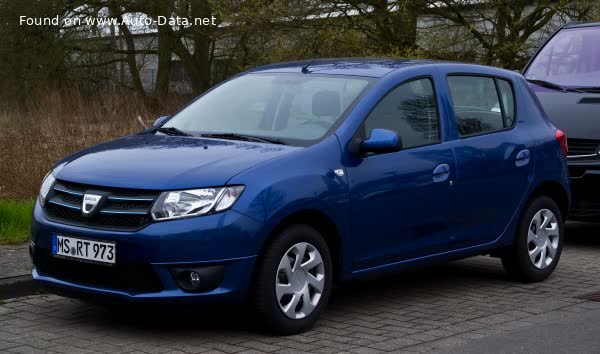Everything you need to know about specifications and performance - Dacia Sandero 2012 - 1.2 (75 Hp) LPG

Overview:
What is the engine capacity of a Dacia Sandero 2012?
The engine capacity of the Dacia Sandero 2012 is 1149.
Dacia Sandero 2012 How many horsepower?
The engine power of the Dacia Sandero 2012 is 75 Hp @ 5500 rpm..
What is the Dacia Sandero 2012 engine?
Dacia Sandero 2012 engine is D4F 734. (Click to see other cars using the same engine)
How much gasoline does a Dacia Sandero 2012 consume?
The Dacia Sandero 2012 consumes 5.9 liters of gasoline per 100 km
General:
Brand: Dacia
Model: Sandero
Generation: II
Modification (Engine): 1.2 (75 Hp) LPG
Start of production: 2012
End of production: 2015
Powertrain Architecture: Internal Combustion Engine
Body type:Hatchback
Seats: 5
Doors: 5
Engine:
Power: 75 hp @ 5500 rpm.
Power per litre: 65.3 hp/l
Torque: 107 nm @ 4250 rpm.
Engine Model/Code:D4F 734
Engine displacement: 1149
Number of cylinders: 4
Engine configuration: Inline
Number of valves per cylinder: 4
Fuel injection system: Multi-port manifold injection
Engine aspiration: Naturally aspirated Engine
Valvetrain: SOHC
Engine oil capacity: 4 l
Coolant: 4.5 l
Engine layout: Front, Transverse
Cylinder Bore: 69 mm
Piston Stroke: 76.8 mm
Compression ratio: 9.8:1
Power (LPG): 72 hp @ 5500 rpm.
Power per litre (LPG): 62.7 hp/l
Torque (LPG): 103 nm @ 4250 rpm.
Performance:
Acceleration 0 - 100 km/h (LPG): 15.1 sec
Fuel Type: Petrol / LPG
Fuel consumption (economy) - urban: 7.7 l/100 km
Fuel consumption (economy) - extra urban: 4.9 l/100 km
Fuel consumption (economy) - combined (NEDC): 5.9 l/100 km
Fuel consumption (economy) - urban (NEDC): 7.7 l/100 km
Fuel consumption (economy) - extra urban (NEDC): 4.9 l/100 km
Fuel consumption (economy) - urban (LPG): 9.8 l/100 km
Fuel consumption (economy) - extra urban (LPG): 6.2 l/100 km
Fuel consumption (economy) - combined (LPG): 7.5 l/100 km
Fuel consumption (economy) - urban (LPG) (NEDC): 9.8 l/100 km
Fuel consumption (economy) - extra urban (LPG) (NEDC): 6.2 l/100 km
Fuel consumption (economy) - combined (LPG) (NEDC): 7.5 l/100 km
Fuel consumption (economy) - combined: 5.9 l/100 km
Emission standard: Euro 5
Acceleration 0 - 100 km/h: 14.5 sec
Acceleration 0 - 62 mph: 14.5 sec
Maximum speed: 162 km/h
Weight-to-power ratio: 13.1 kg/Hp, 76.5 Hp/tonne
Weight-to-torque ratio: 9.2 kg/Nm, 109.2 Nm/tonne
Acceleration 0 - 60 mph: 13.8 sec
Space:
Kerb Weight (kg): 980
Max. weight (kg): 1540
Max. roof load: 80 kg
Max load (kg): 560
Trunk (boot) space - maximum: 1200 l
Trunk (boot) space - minimum: 320 l
Permitted trailer load with brakes (12%): 1100 kg
Fuel tank capacity: 50 l
Fuel tank capacity (LPG): 32 l
Permitted trailer load without brakes: 525 kg
Permitted towbar download: 58 kg
dimensions:
Length: 4057 mm
Width: 1733 mm
Height: 1523 mm
wheelbase: 2589 mm
Width including mirrors: 1984 mm
Front track: 1497 mm
Rear (Back) track: 1486 mm
Front overhang: 818 mm
Rear overhang: 650 mm
Ride height (ground clearance): 163 mm
Minimum turning circle (turning diameter): 10.68 m
Powertrain, Suspension and Brakes:
Drivetrain Architecture: The Internal combustion Engine (ICE) drives the front wheels of the vehicle.
Drive wheel: Front wheel drive
Number of gears and type of gearbox: 5 gears, manual transmission
Front brakes: Ventilated discs, 258x22 mm
Rear brakes: Drum, 203 mm
Assisting systems: ABS (Anti-lock braking system)
Steering type: Steering rack and pinion
Power steering: Electric Steering
Tires size: 185/65 R15
Wheel rims size: 6J x 15
Front suspension: Independent type McPherson, Transverse stabilizer
Rear suspension: Coil spring, Torsion
See also

Last generation.
Its production began in 2022 until Now

Same engine. (D4F 734).
Its production began in 2012 until 2016

Write a comment